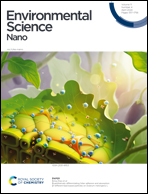Molecular mechanisms of dimethylarsinic acid adsorption onto aluminum substituted ferrihydrite surfaces†
Abstract
Dimethylarsinic acid (DMA) is a common organic arsenic pollutant in the environment, and its distribution, migration, and transformation are greatly controlled by various active minerals. However, the bonding mechanisms of DMA on aluminum (Al)-substituted ferrihydrite is rarely explored. Here, ferrihydrite samples with Al substitution amounts of 0.00 ± 0.00 mol%, 3.02 ± 0.01 mol%, 6.71 ± 0.11 mol%, 12.89 ± 0.34 mol%, and 20.50 ± 0.76 mol% were prepared, characterized, and used to test DMA adsorption behaviors and mechanisms. With the increase of Al amount, the particle size and specific surface area of ferrihydrite particles slightly decrease, and the point of zero charge gradually increases. The reaction pH has a significant impact on the DMA adsorption onto mineral surfaces. When the pH is 3–6, the DMA adsorption density is almost unchanged being 0.74–0.77 μmol m−2; while pH > 6, the DMA adsorption density significantly decreases. With the increase in ionic strength, the DMA adsorption density onto Al-substituted ferrihydrite is almost unaffected at pH 6, but is greatly increased at pH 9. Isothermal adsorption experiments show that Al substitution significantly improves the DMA adsorption density on ferrihydrite by 46–61%, with a maximum enhancement at an Al substitution level of 6.70 mol%. Ionic strength effect test, Fourier transform infrared spectroscopy and As K-edge extended X-ray absorption fine structure spectroscopy analysis show that DMA forms bidentate binuclear inner-sphere complexes on ferrihydrite surfaces through As–OH rather than the –CH3 group at pH 6, but predominantly forms outer-sphere complexes at pH 9. With the increase of the Al substitution level in the mineral, DMA also forms monodentate mononuclear and outer-sphere complexes on solids at pH 6. These results provide deep insights into the interaction mechanisms and fates of organoarsenicals with natural Fe (hydr)oxide minerals.



 Please wait while we load your content...
Please wait while we load your content...